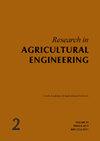A study on the influence of the loading rate and orientation on some mechanical properties of cassava tubers of different ages
Q3 Agricultural and Biological Sciences
引用次数: 0
Abstract
The study determined the effects of the speed of loading and the loading orientation on some selected mechanical properties of the TME 419 cassava tuber variety at different ages of the tuber which are essential in the design and construction of the processing and handling equipment of a cassava peeler. The properties considered include the bioyield and rupture points, compressive and rupture strengths, toughness and firmness, and moduli of stiffness and toughness, which were carried out in the transverse and longitudinal loading direction using an Instron Universal Testing Machine (UTM). As the loading rate increased from 5.00 to10.00 mm·min–1 and the age of the tuber varies from 1.00 to 2.00 years, the bioyield and rupture points, compressive and rupture strengths, toughness, firmness, moduli of stiffness and toughness in the transverse and longitudinal direction varies from 1 619.61 to 3 636.19 N and 136.08 to 384.52 N, 0.48066 to 1.07913 N·mm–2 and 0.26604 to 0.75173 N·mm–2, 766 to 1 055 N·mm–1 and 1 262 to 2 965 N·mm–1, 303.98 to 553.68 mm·min–1 and 28.08 to 53.71 mm·min–1 2.30 to 4.19 N·mm–2 and 5.376 to 8.94 N·mm–2 respectively. Generally, the values of the properties examined are higher in the longitudinal loading orientation than in the transverse and for a year and half old tuber which will be useful in designing an efficient cassava peeling system.加载速率和方位对不同树龄木薯块茎某些力学性能影响的研究
本研究确定了加载速度和加载方向对TME 419木薯块茎品种在不同树龄下的一些选定力学性能的影响,这些性能对木薯削皮机加工和搬运设备的设计和建造至关重要。所考虑的性能包括生物屈服点和断裂点、抗压强度和断裂强度、韧性和硬度以及刚度和韧性模量,这些都是使用Instron通用试验机(UTM)在横向和纵向加载方向上进行的。当加载速率从5.00增加到1.00 mm·min–1,块茎的年龄从1.00年变化到2.00年时,块茎的生物屈服点和断裂点、抗压强度和断裂强度、韧性、硬度、刚度模量和韧性在横向和纵向上分别从1 619.61到3 636.19 N和136.08到384.52 N,0.48066至1.07913 N·mm–2和0.26604至0.75173 N·mm-2、766至1 055 N·mm-1和1 262至2 965 N·mm-1、303.98至553.68 mm·min-1和28.08至53.71 mm·min-2分别为2.30至4.19 N·mm-2和5.376至8.94 N·mm-2。通常,所检查的特性值在纵向负载方向上高于在横向和一年半的块茎上,这将有助于设计有效的木薯去皮系统。
本文章由计算机程序翻译,如有差异,请以英文原文为准。
求助全文
约1分钟内获得全文
求助全文
来源期刊

Research in Agricultural Engineering
Engineering, agriculture-
CiteScore
1.40
自引率
0.00%
发文量
21
审稿时长
24 weeks
期刊介绍:
Original scientific papers, short communications, information, and studies covering all areas of agricultural engineering, agricultural technology, processing of agricultural products, countryside buildings and related problems from ecology, energetics, economy, ergonomy and applied physics and chemistry. Papers are published in English.
 求助内容:
求助内容: 应助结果提醒方式:
应助结果提醒方式:


